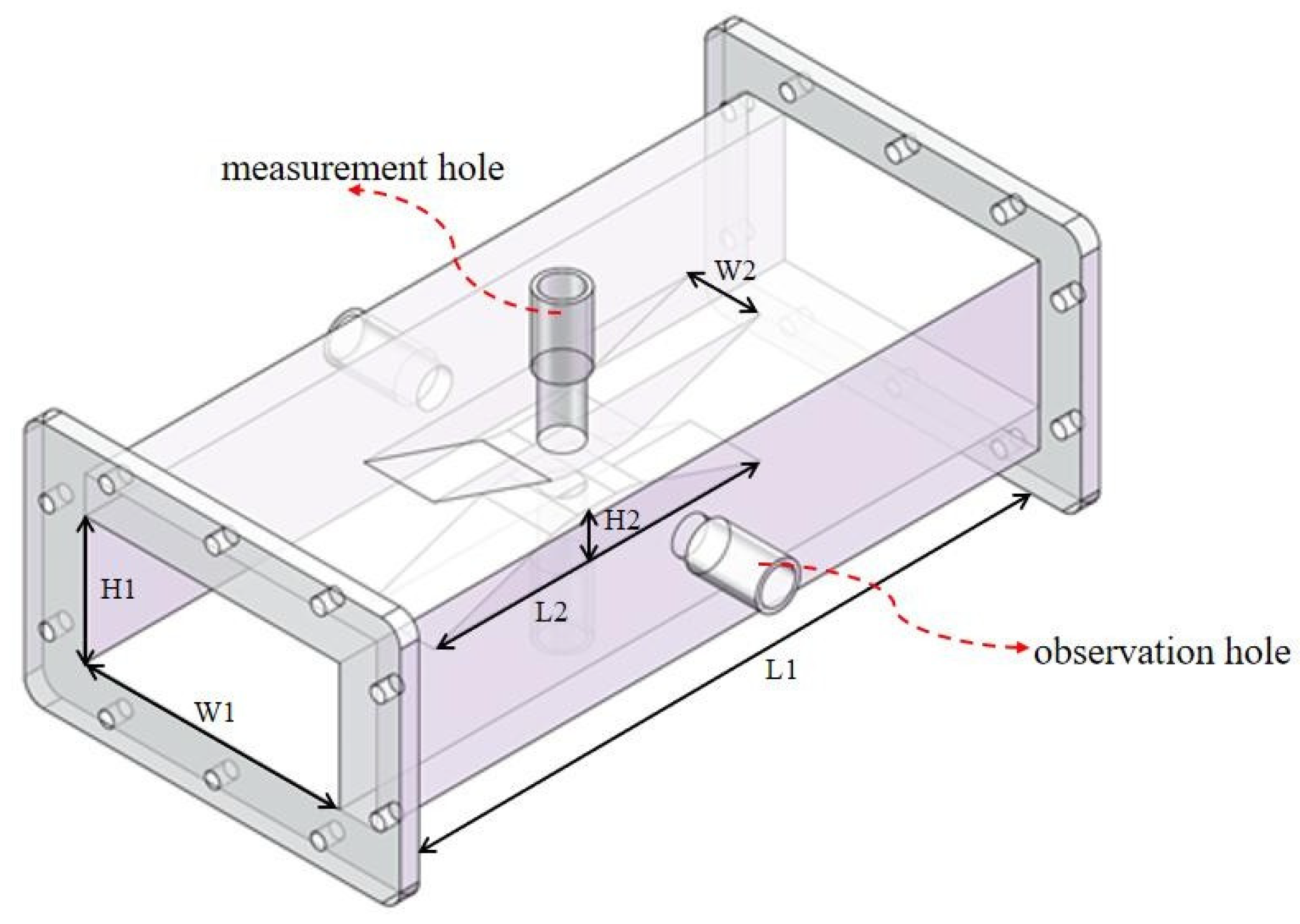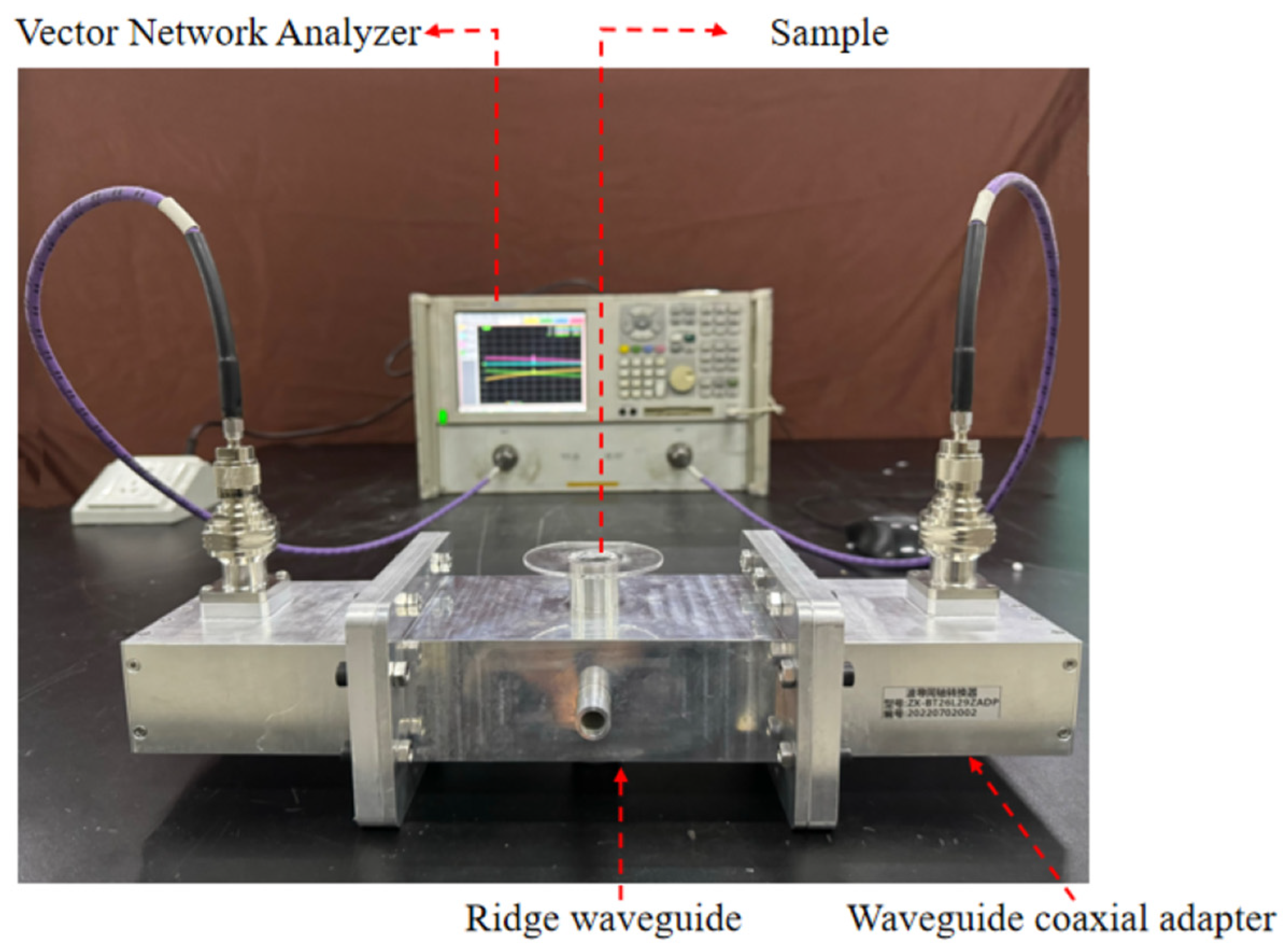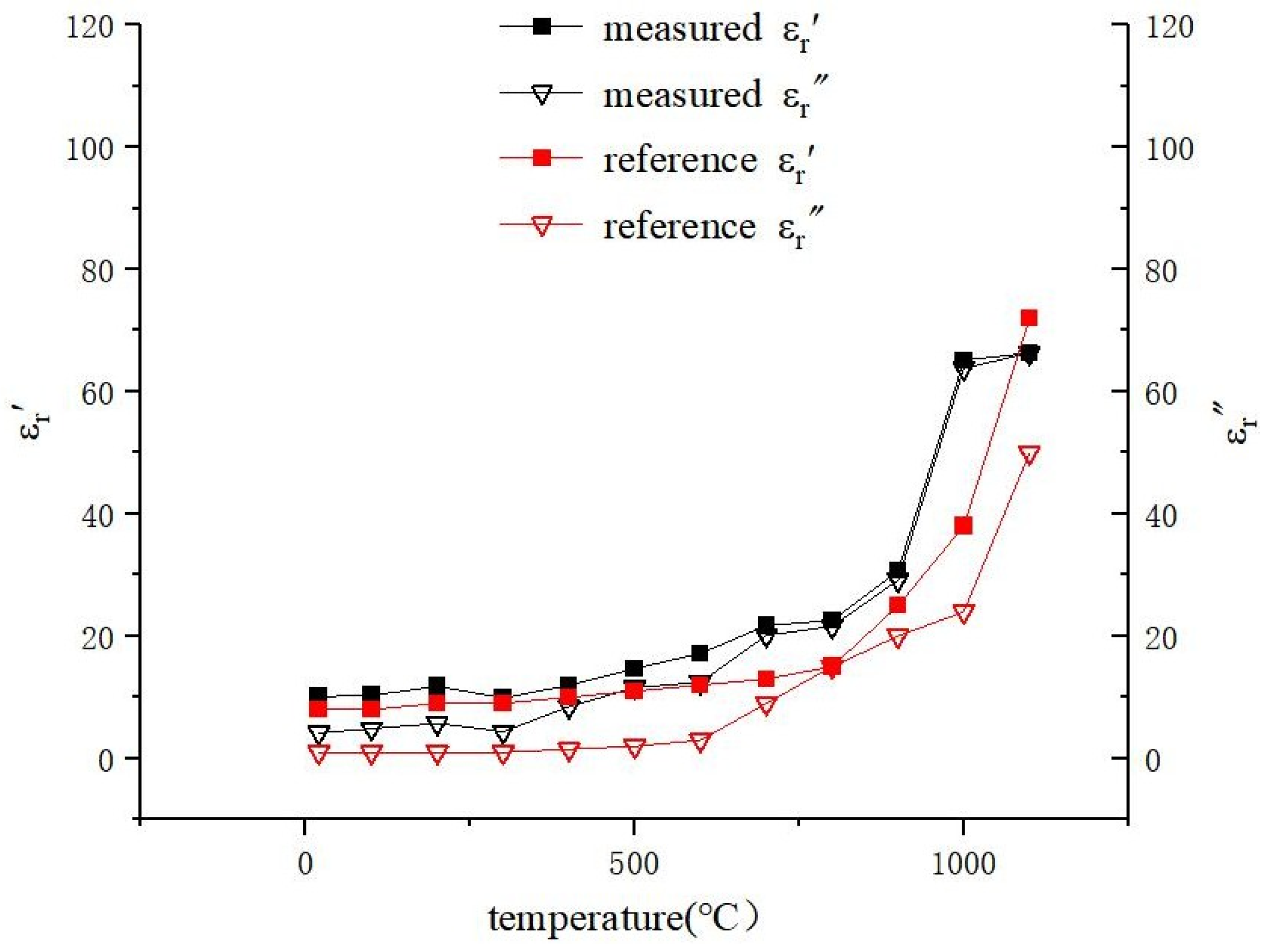A High-Temperature and Wide-Permittivity Range Measurement System Based on Ridge Waveguide
Abstract
:1. Introduction
2. Materials and Methods
2.1. Ridge Waveguide Measurement System
2.2. Simulation Parameter Setting and Result Analysis
2.3. Artificial Neural Network (ANN)
3. Results and Discussion
4. Conclusions
Author Contributions
Funding
Institutional Review Board Statement
Informed Consent Statement
Data Availability Statement
Conflicts of Interest
References
- Liao, X.; Liu, Q.; Chen, J.; Hu, T.; Zhang, L.; Chen, G.; Peng, J. Research Status of Microwave Heating in Drying Processes. Compr. Util. Miner. Resour. 2016, 4, 1–5. [Google Scholar]
- Pickles, C.A. Microwaves in Extractive Metallurgy: Part 2—A Review of Applications. Miner. Eng. 2009, 22, 1112–1118. [Google Scholar] [CrossRef]
- Ma, Y.; Chen, X.; Chen, Y. Experimental Study on Microwave-Assisted Vanadium Leaching Process. J. Xi’an Univ. Archit. Technol. Nat. Sci. Ed. 2013, 3, 452–456. [Google Scholar]
- Li, Y.; Zhao, G.; Li, H. Research Progress on the Application of Microwave Heating Technology in the Nuclear Industry. Appl. Chem. 2024, 53, 1166–1169, 1174. [Google Scholar] [CrossRef]
- Singh, G.; Mohod, S.; Varma, P.; Purohit, P.; Sathe, D.; Bhatt, R. Direct Configuration Mode Microwave Sintering of Natural Uranium Dioxide Pellets. Ceram. Int. 2023, 49, 18969–18976. [Google Scholar] [CrossRef]
- Chen, J. Study on Microwave Heating Pretreatment Process of Chromite Ore. Master’s Thesis, Kunming University of Science and Technology, Kunming, China, 2013. [Google Scholar]
- Gao, H.; Yang, X.; Zhou, B.; He, Q.; Wei, L.-F. Coupling-Induced Microwave Transmission Transparency with Quarter-Wavelength Superconducting Resonators. Acta Phys. Sin. 2022, 71, 337–345. [Google Scholar] [CrossRef]
- Ochi, H.; Shimamoto, S.; Liu, J.; Yamaoka, Y. Non-contact blood pressure estimation with pulse wave employing microwave reflection. In Proceedings of the IEEE International Conference on Communications Workshops, Montreal, QC, Canada, 14–23 June 2021; pp. 1–6. [Google Scholar]
- Choe, H.S.; Lee, J.S.; Kweon, J.H.; Nam, Y.W.; Choi, W.H. High-performance microwave absorption heating honeycomb sandwich composite with electroless nickel-plated glass fiber. Compos. Struct. 2022, 283, 115138. [Google Scholar] [CrossRef]
- Lynch, A.C. Precise Measurement on Dielectric and Magnetic Materials. IEEE Trans. Instrum. Meas. 1974, 23, 425–430. [Google Scholar] [CrossRef]
- Cook, R.J.; Jones, R.G.; Rosenberg, C.B. Comparison of Cavity and Open-Resonator Measurements of Permittivity and Loss Angle at 35 GHz. IEEE Trans. Instrum. Meas. 1974, 23, 438–442. [Google Scholar] [CrossRef]
- Kobayashi, Y.; Katoh, M. Microwave Measurement of Dielectric Properties of Low-Loss Materials by the Dielectric Rod Resonator Method. IEEE Trans. Microw. Theory Tech. 1985, 33, 586–592. [Google Scholar] [CrossRef]
- Ghodgaonkar, D.K.; Varadan, V.V.; Varadan, V.K. A Free-Space Method for Measurement of Dielectric Constants and Loss Tangents at Microwave Frequencies. IEEE Trans. Instrum. Meas. 1989, 38, 789–793. [Google Scholar] [CrossRef]
- Stuchly, M.A.; Stuchly, S.S. Coaxial Line Reflection Methods for Measuring Dielectric Properties of Biological Substances at Radio and Microwave Frequencies—A Review. IEEE Trans. Instrum. Meas. 1980, 29, 176–183. [Google Scholar] [CrossRef]
- Decreton, M.C.; Gardiol, F.E. Simple Nondestructive Method for the Measurement of Complex Permittivity. IEEE Trans. Instrum. Meas. 1974, 23, 434–438. [Google Scholar] [CrossRef]
- Ligthart, L.P. A Fast Computational Technique for Accurate Permittivity Determination Using Transmission Line Methods. IEEE Trans. Microw. Theory Tech. 1983, 31, 249–254. [Google Scholar] [CrossRef]
- Soltan, A.; Sadeghzadeh, R.A.; Mohammad-Ali-Nezhad, S. Microwave Sensor for Liquid Classification and Permittivity Estimation of Dielectric Materials. Sens. Actuators A Phys. 2022, 336, 113397. [Google Scholar] [CrossRef]
- Abd Rahman, N.; Zakaria, Z.; Abd Rahim, R.; Alahnomi, R.A.; Al-Gburi, A.J.A.; Alhegazi, A.; Bahar, A.A.M. Liquid Permittivity Sensing Using Teeth Gear-Circular Substrate Integrated Waveguide. IEEE Sens. J. 2022, 22, 11690–11697. [Google Scholar] [CrossRef]
- Wang, C.; Liu, X.; Huang, Z.; Yu, S.; Yang, X.; Shang, X. A Sensor for Characterisation of Liquid Materials with High Permittivity and High Dielectric Loss. Sensors 2022, 22, 1764. [Google Scholar] [CrossRef] [PubMed]
- Liu, C.; Liao, C.; Peng, Y.; Zhang, W.; Wu, B.; Yang, P. Microwave Sensors and Their Applications in Permittivity Measurement. Sensors 2024, 24, 7696. [Google Scholar] [CrossRef] [PubMed]
- Yang, R.B.; Tsay, C.Y.; Hung, D.S.; Liang, W.F.; Yao, Y.D.; Lin, C.K. Complex Permittivity and Permeability of Iron-Based Composite Absorbers Measured by Cavity Perturbation Method in X-Band Frequency Range. J. Appl. Phys. 2009, 105, 07A528. [Google Scholar] [CrossRef]
- Misra, D.; Chabbra, M.; Epstein, B.R.; Microtznik, M.; Foster, K. Noninvasive Electrical Characterization of Materials at Microwave Frequencies Using an Open-Ended Coaxial Line: Test of an Improved Calibration Technique. IEEE Trans. Microw. Theory Tech. 1990, 38, 8–14. [Google Scholar] [CrossRef]
- Weir, W.B. Automatic Measurement of Complex Dielectric Constant and Permeability at Microwave Frequencies. Proc. IEEE 1974, 62, 36–38. [Google Scholar] [CrossRef]
- Nicolson, A.M.; Ross, G.F. Measurement of the Intrinsic Properties of Materials by Time-Domain Techniques. IEEE Trans. Instrum. Meas. 1970, 19, 377–382. [Google Scholar] [CrossRef]
- Hasar, U.C. A fast and accurate amplitude-only transmission-reflection method for complex permittivity determination of lossy materials. IEEE Trans. Microw. Theory Tech. 2008, 56, 2129–2135. [Google Scholar] [CrossRef]
- Peng, Z.; Hwang, J.Y.; Park, C.L.; Kim, B.G.; Andriese, M.; Wang, X. Microwave Permittivity, Permeability, and Absorption Capability of Ferric Oxide. ISIJ Int. 2012, 52, 1535–1538. [Google Scholar] [CrossRef]
- Peng, Z.; Hwang, J.Y.; Mouris, J.; Hutcheon, R.; Huang, X. Microwave Penetration Depth in Materials with Non-Zero Magnetic Susceptibility. ISIJ Int. 2010, 50, 1590–1596. [Google Scholar] [CrossRef]
- Gou, M.; Chen, Q.; Dong, P.; Liu, C.; Huang, K. Design of a Microwave Heating and Permittivity Measurement System Based on Oblique Aperture Ridge Waveguide. Sensors 2023, 23, 4035. [Google Scholar] [CrossRef] [PubMed]
- Solyom, K.; Lopez, P.R.; Esquivel, P.; Lucia, A. Effect of Temperature and Moisture Contents on Dielectric Properties at 2.45 GHz of Fruit and Vegetable Processing By-Products. RSC Adv. 2020, 10, 16783–16790. [Google Scholar] [CrossRef] [PubMed]
- Liu, C.; Tong, F. An SIW Resonator Sensor for Liquid Permittivity Measurements at C Band. IEEE Microw. Wirel. Compon. Lett. 2015, 25, 751–753. [Google Scholar]
- Liu, C.; Pu, Y. A Microstrip Resonator with Slotted Ground Plane for Complex Permittivity Measurements of Liquids. IEEE Microw. Wirel. Compon. Lett. 2008, 18, 257–259. [Google Scholar]
- Chen, Q.; Long, Z.; Shinohara, N.; Liu, C. A Substrate Integrated Waveguide Resonator Sensor for Dual-Band Complex Permittivity Measurement. Processes 2022, 10, 708. [Google Scholar] [CrossRef]
- Chen, Q.; Huang, K.; Zeng, X.; Liu, C. Note: Coaxial Apparatus to Measure the Permittivities of Chemical Solutions at Microwave Frequencies. Rev. Sci. Instrum. 2017, 88, 046102. [Google Scholar] [CrossRef] [PubMed]
- Ni, E.; Jiang, X. Microwave Measurement of the Permittivity for High Dielectric Constant Materials Using an Extra-Cavity Evanescent Waveguide. Rev. Sci. Instrum. 2002, 73, 3997–4002. [Google Scholar] [CrossRef]
- Bolivar, P.H.; Brucherseifer, M.; Rivas, J.G.; Gonzalo, R.; Ederra, I.; Reynolds, A.L.; Holker, M.; De Maagt, P. Measurement of the Dielectric Constant and Loss Tangent of High Dielectric-Constant Materials at Terahertz Frequencies. IEEE Trans. Microw. Theory Tech. 2003, 51, 1062–1066. [Google Scholar] [CrossRef]
- Martín, F.; Vélez, P.; Gil, M. Microwave Sensors Based on Resonant Elements. Sensors 2020, 20, 3375. [Google Scholar] [CrossRef]
- Lamb, J. Dielectric measurement at wavelengths around 1cm by means of an H01 cylinderical-cavity resonator. J. Inst. Electr. Eng. Part IIIA Radiolocation 1946, 93, 1447–1451. [Google Scholar]
- Yang, X.Q. Study on Special Effects in the Interaction Between Microwave and Chemical Reaction System. Ph.D. Thesis, Sichuan University, Chengdu, China, 2006. [Google Scholar]
- Coello, C.A. An updated survey of GA-based multiobjective optimization techniques. ACM Comput. Surv. (CSUR) 2000, 32, 109–143. [Google Scholar] [CrossRef]
- Wang, J.; Liu, H.; Jiang, P.; Wang, Z.; Sui, Q.; Zhang, F. GPRI2Net: A Deep-Neural-Network-Based Ground Penetrating Radar Data Inversion and Object Identification Framework for Consecutive and Long Survey Lines. IEEE Trans. Geosci. Remote Sens. 2021, 60, 5106320. [Google Scholar] [CrossRef]
- Liu, B.; Guo, Q.; Li, S.; Liu, B.; Ren, Y.; Pang, Y.; Guo, X.; Liu, L.; Jiang, P. Deep Learning Inversion of Electrical Resistivity Data. IEEE Trans. Geosci. Remote Sens. 2020, 58, 5715–5728. [Google Scholar] [CrossRef]
- Kazemi, N.; Abdolrazzaghi, M.; Musilek, P.; Daneshmand, M. A Temperature-Compensated High-Resolution Microwave Sensor Using Artificial Neural Network. IEEE Microw. Wirel. Compon. Lett. 2020, 30, 919–922. [Google Scholar] [CrossRef]
- Hao, H.; Wang, D.X.; Wang, Z. A Permittivity Measurement Method Based on Back Propagation Neural Network by Microwave Resonator. Prog. Electromagn. Res. C 2021, 110, 27–38. [Google Scholar] [CrossRef]
- Glorot, X.; Bordes, A.; Bengio, Y. Deep Sparse Rectifier Neural Networks. In Proceedings of the 14th International Conference on Artificial Intelligence and Statistics (AISTATS), Ft. Lauderdale, FL, USA, 11–13 April 2011; pp. 315–323. [Google Scholar]
- Gan, H.Y.; Zhao, W.S.; Liu, Q.; Wang, D.W.; Dong, L.; Wang, G.; Yin, W.Y. Differential Microwave Microfluidic Sensor Based on Microstrip Complementary Split-Ring Resonator (MCSRR) Structure. IEEE Sens. J. 2020, 20, 5876–5884. [Google Scholar] [CrossRef]
- Bonkerud, J.; Zimmermann, C.; Weiser, P.M.; Vines, L.; Monakhov, E.V. On the Permittivity of Titanium Dioxide. Sci. Rep. 2021, 11, 12443. [Google Scholar] [CrossRef] [PubMed]
- Djemmah, D.A.; Roux, J.F.; Geffroy, P.M.; Bouamrame, F.; Akmansoy, E.; Chartier, T. Characterization of High Permittivity and Low Losses TiO2 Sintered Material for THz Applications. In Proceedings of the 2022 47th International Conference on Infrared, Millimeter and Terahertz Waves (IRMMW-THz), Delft, The Netherlands, 28 August–2 September 2022; IEEE: Piscataway, NJ, USA, 2022; pp. 1–2. [Google Scholar]
- Maruoka, D.; Nanko, M. Improved crack healing and high-temperature oxidation resistance of Ni/Al2O3 by Y or Si doping. J. Am. Ceram. Soc. 2016, 99, 2451–2457. [Google Scholar] [CrossRef]
- Kimura, T.; Ohfuji, H.; Nishi, M.; Irifune, T. Melting temperatures of MgO under high pressure by micro-texture analysis. Nat. Commun. 2017, 8, 15735. [Google Scholar] [CrossRef] [PubMed]
- Zheng, Z.; Wang, S.; Long, J.; Wang, J.; Zheng, K. Effect of rare earth elements on high temperature oxidation behaviour of austenitic steel. Corros. Sci. 2020, 164, 108359. [Google Scholar] [CrossRef]









| Liquid to Be Measured | Waveguide (ε′) | Probe (ε′) | Errors (%) | Waveguide (tanδ) | Probe (tanδ) | Errors (%) |
|---|---|---|---|---|---|---|
| Water/ethanol = 0:10 | 7.642 | 7.940 | 3.753 | 0.883 | 0.894 | 1.230 |
| Water/ethanol = 1:9 | 13.968 | 13.100 | 6.626 | 0.846 | 0.806 | 4.963 |
| Water/ethanol = 2:8 | 20.706 | 20.620 | 0.417 | 0.667 | 0.644 | 3.571 |
| Water/ethanol = 3:7 | 27.779 | 28.505 | 2.547 | 0.528 | 0.525 | 0.571 |
| Water/ethanol = 4:6 | 34.539 | 35.293 | 2.136 | 0.468 | 0.453 | 3.311 |
| Water/ethanol = 5:5 | 41.734 | 43.084 | 3.133 | 0.405 | 0.378 | 7.143 |
| Water/ethanol = 6:4 | 48.361 | 51.120 | 5.397 | 0.352 | 0.328 | 7.317 |
| Water/ethanol = 7:3 | 56.774 | 57.325 | 0.961 | 0.259 | 0.270 | 4.074 |
| Water/ethanol = 8:2 | 63.052 | 65.822 | 4.208 | 0.219 | 0.210 | 4.286 |
| Water/ethanol = 9:1 | 67.147 | 71.578 | 6.190 | 0.171 | 0.155 | 10.322 |
| Water/ethanol = 10:0 | 75.593 | 77.370 | 2.297 | 0.122 | 0.123 | 0.813 |
| Reference Value (ε′) | Test Value (ε′) | Reference Value (tanδ) | Test Value (tanδ) |
|---|---|---|---|
| 105 | 108 | 0.275 | 0.286 |
Disclaimer/Publisher’s Note: The statements, opinions and data contained in all publications are solely those of the individual author(s) and contributor(s) and not of MDPI and/or the editor(s). MDPI and/or the editor(s) disclaim responsibility for any injury to people or property resulting from any ideas, methods, instructions or products referred to in the content. |
© 2025 by the authors. Licensee MDPI, Basel, Switzerland. This article is an open access article distributed under the terms and conditions of the Creative Commons Attribution (CC BY) license (https://creativecommons.org/licenses/by/4.0/).
Share and Cite
Xiong, R.; Hu, Y.; Xia, A.; Huang, K.; Yan, L.; Chen, Q. A High-Temperature and Wide-Permittivity Range Measurement System Based on Ridge Waveguide. Sensors 2025, 25, 541. https://doi.org/10.3390/s25020541
Xiong R, Hu Y, Xia A, Huang K, Yan L, Chen Q. A High-Temperature and Wide-Permittivity Range Measurement System Based on Ridge Waveguide. Sensors. 2025; 25(2):541. https://doi.org/10.3390/s25020541
Chicago/Turabian StyleXiong, Rui, Yuanhang Hu, Anqi Xia, Kama Huang, Liping Yan, and Qian Chen. 2025. "A High-Temperature and Wide-Permittivity Range Measurement System Based on Ridge Waveguide" Sensors 25, no. 2: 541. https://doi.org/10.3390/s25020541
APA StyleXiong, R., Hu, Y., Xia, A., Huang, K., Yan, L., & Chen, Q. (2025). A High-Temperature and Wide-Permittivity Range Measurement System Based on Ridge Waveguide. Sensors, 25(2), 541. https://doi.org/10.3390/s25020541





